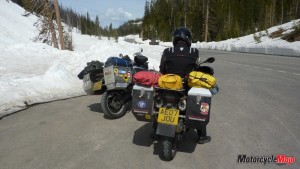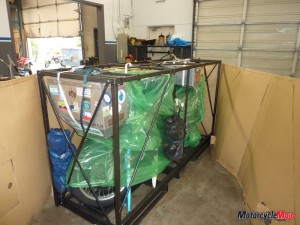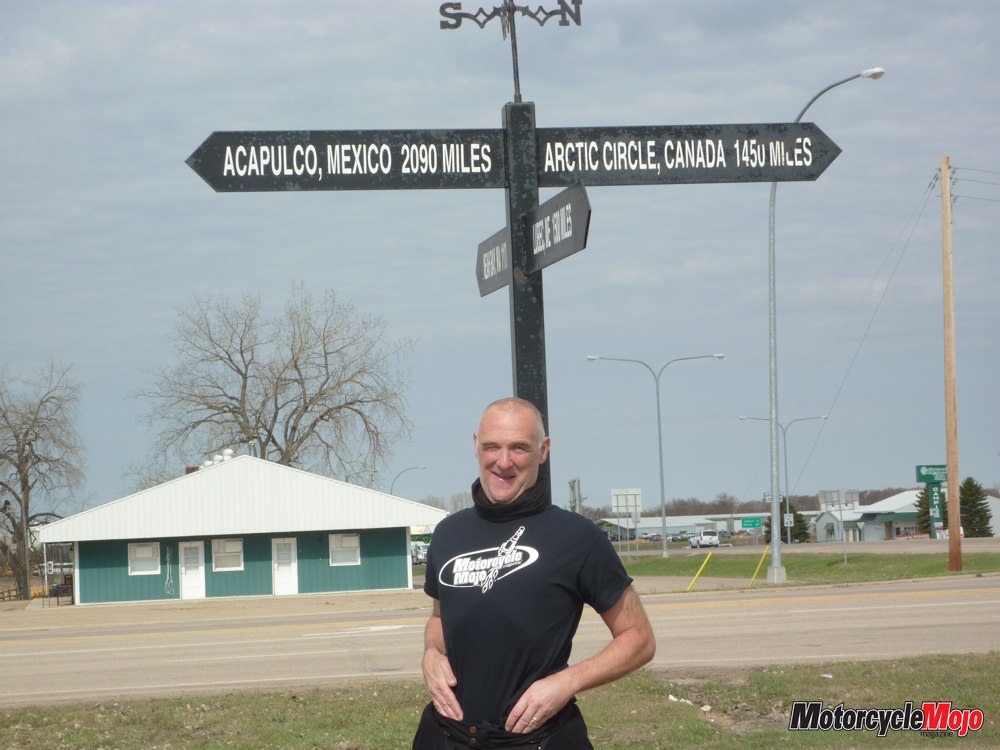For a pair of Brits, Canada was the first leg of an ambitious attempt to ride around the world in 91 days.
Click. Click. This is not the sound you want to hear from your travelling companion’s bike on the second day of your round-the-world trip. In ten days, the bikes needed to be in Seattle for shipping to Russia. Now we were sitting in a Quebec service-station parking lot, sweating after failing to push-start the bike. Mike tested the battery – replaced just 10 days previously – and it was flat.
Eighteen months earlier, tired of seeing Mike stare at the world map on his kitchen wall, I suggested it was time to stop thinking about it – we should just get on with it and do the trip. Because I am self-employed, I was able to leave at any moment, for any length of time. All Mike needed was to get leave from his manager and set the date. A few weeks later, he called and announced that we had to leave on May 1, 2013. Then he delivered the killer line: we had to be back in 91 days.
Mike Speechley is the commercial manager for three student union bars in Manchester, England. He is required to be back at work for “fresher’s week,” when all the new students arrive to spend their easily gained loans.
I, on the other hand, work with computers. After I was paid off by Sun Microsystems in 2009, my wife and I set off on a bike trip across all three Americas. Upon our return, we started to work with the sole intention of further travel.
 Both Mike and I are married, with children. Our wives were school friends, which is how we know each other. In both cases we married young, in our early 20s, followed quickly by the children and more than 25 years of daily grind to pay for houses and university.
Both Mike and I are married, with children. Our wives were school friends, which is how we know each other. In both cases we married young, in our early 20s, followed quickly by the children and more than 25 years of daily grind to pay for houses and university.
With our time off sorted out, organizing and planning kicked in immediately. We split tasks between us. I took on the task of freighting the bikes between the United Kingdom, North America and Asia/Russia. Mike took on the route planning and researching the visa requirements of the various countries. As far as I was concerned, it was Mike’s trip. I was just along for the ride; I like long bike rides.
The main sources for planning a trip on this scale are Horizons Unlimited (horizonsunlimited.com) and Advrider (advrider.com); I prefer the HUBB (forum) on Horizons Unlimited. With so much information on these sites, immense reading is required to find what is relevant to you, as many threads go off subject and the search engines can be a bit hit and miss. However, we were able to gather enough information to aid our major decisions.
Our initial question was “which way round?” Most northern hemisphere RTW (round the world) riders seem to prefer west to east, but we felt this presented one big issue for us. Whichever direction we chose, the big hold up, time wise, would likely be getting the bikes shipped between Asia and North America. We decided that if any time were lost early in the trip in North America, we would be able to make it up crossing Russia and Europe. It was also very important to both of us that we should ride the bikes all the way home as opposed to leaving them in North America and flying home without them. We experienced that on our previous, less ambitious trip riding Route 66 with our wives in 2007.
I gathered a list of shippers, freighters and agents, then sent them all emails explaining what we were doing and what we needed. Of those who replied, I selected the ones that best understood our needs.
 As we both live in northwest England – Liverpool for me and Manchester for Mike – the discovery of a RoRo (Roll On Roll Off) ferry for the bikes between Liverpool and Halifax, Nova Scotia, got us all excited, especially since we could get a flight to Halifax arriving two days after the bikes.
As we both live in northwest England – Liverpool for me and Manchester for Mike – the discovery of a RoRo (Roll On Roll Off) ferry for the bikes between Liverpool and Halifax, Nova Scotia, got us all excited, especially since we could get a flight to Halifax arriving two days after the bikes.
Stage one sorted, we moved on to shipping the bikes to South Korea. Our preferred option was to catch a ferry to Vladivostok, Russia, as, unlike Japan, no carnet de passages is required. Our jaws dropped when we received a quote of $4,000CAD per bike, which did not include crating or draining gas tanks. Unable to find anything cheaper, we swallowed hard, accepted the cost and carried on planning. But I had come across a few references to a RoRo between the United States and Vladivostok. I persisted until I found the freight company Fesco (fesco.ru/en/) – it even fit in with our planned landing in Vladivostok on June 1. There was only one catch: the bikes needed to be in the port on May 13, one week before sailing, because of U.S. customs restrictions.
With all the major planning done, only two things remained: how to pay for it, and how to reassure our wives that we were not going to run off, bankrupt the family finances, or fall into the arms of busty Russian women. The money side was simple; it just takes years of saving small amounts of money. Or, in my case, working short-term contracts and long hours. It is hard work, but pays reasonably well. While our wives, Jean and Moira, both supported us during the planning stages, we were always aware of the need to allay any fears and worries they may have. Jean and I discussed my offer to go with Mike before I actually went ahead with it. Jean and I usually travel together on one bike each, with Mike and Moira on another bike. The four of us have done many short trips together, as well as the one long one to the United States in 2007.
Jean and I also rode two bikes across all three Americas three years ago. We were effectively breaking up two teams and creating a new one. As the time to depart drew nearer, tensions were raised and worries were aired. Would we come home? Would it just be Mike and I travelling in future, not with our partners? Would they have to earn the money to fuel our passions? Would we keep in touch? But eventually we reached compromises, and now here we were in Canada. We set about working on Mike’s bike, swapping my battery in and testing the charging circuit – we were both riding identical bikes. The relief was verbal when we saw fourteen volts generated by the engine. With the aid of directions from a local, I rode off to a nearby bike dealer to practice my French skills by buying a battery in Quebec. We needed to wait over four hours to get the battery charged, collect and fit it, then hit the road. Over the next three days, we clawed back the miles that would enable us to make the ferry in Seattle in 10 days’ time, still over 5000 kilometres away. Then we received an email that the ferry was delayed by two weeks, putting our visas for Russia and onwards at stake. Our hearts sank; we were gutted.
Visas for Russia and the “Stans” have fixed start and end dates. As we planned to go to the Aral Sea and gawk at the ships stranded high and dry a long way from any water, we had arranged visas for Kazakhstan and Uzbekistan. Arranging the visa entries and exits is a balancing act. For Russia, we had three-month, double-entry “cultural business” visas. But the two “Stans” were only for 30-day periods. To get the visas, we used an agency, Real Russia, to help us sneak the Russian applications in early to bypass the “45 days before entry” rule. This delay meant a lot of work and money was about to go down the drain. All the next day, we both swore a lot in our helmets and mulled over what to do. That night, we revisited all our previous shipping options, and re-read freight information on Horizonsunlimited, where another RTW rider mentioned an air freight company in Vancouver, B.C. I fired off an email, followed up with phone calls (Skype and McDonalds are a global traveller’s best friends). They quoted less than $2,000 per bike to fly them to Seoul, South Korea; we could then get a ferry to Vladivostok. Suddenly, we had time to play. Our own flight to Seoul was not until May 27. We veered off our westbound course and headed south to Yellowstone, via the Custer battlefields, then on to the salt flats of the Bonneville speedway in Utah – because we could. As we turned north again, I received an email from Jim, who lives near San Diego, California.
Three years ago, while in Mexico with Jean, I bumped into Jim at a gas station – and then later crashed into him on his BMW 1200 GS twice in the same day. Somehow, we have still remained friends. Now he was heading north to ride the “Lost Coast” of northern California. Would we care to join him? It suited us and our newfound time frame. He found us near Eureka, California, while I was trying to track down a marine upholsterer to fix the zipper on my textile jacket. For three days, we were guided through roads we would not normally have seen, camped in the woods and rode the Pacific Coast Highway 101. Finally, Mike and I arrived in Vancouver, B.C., where we spent a day crating the bikes. The crates were supplied by Pacific Motosports of Richmond, B.C., the deal arranged by Roger Parsons of Motorcycle Mojo. All plans at this point were being made on the hoof. But these were the two smoothest-flowing days of organization we had experienced since leaving Halifax. The crates were collected the next day and arrived minutes after us at the freighters. Then, because we had narrowed the bikes while crating, the price calculation went down, despite an increase in weight for using metal crates. Our final shock was the fuel cost coming down, reducing the overall bill further. Canada rocks! Hopefully, when we roll our bikes off in the harbour at Vladivostok, the 91-day target will be back on track.

























